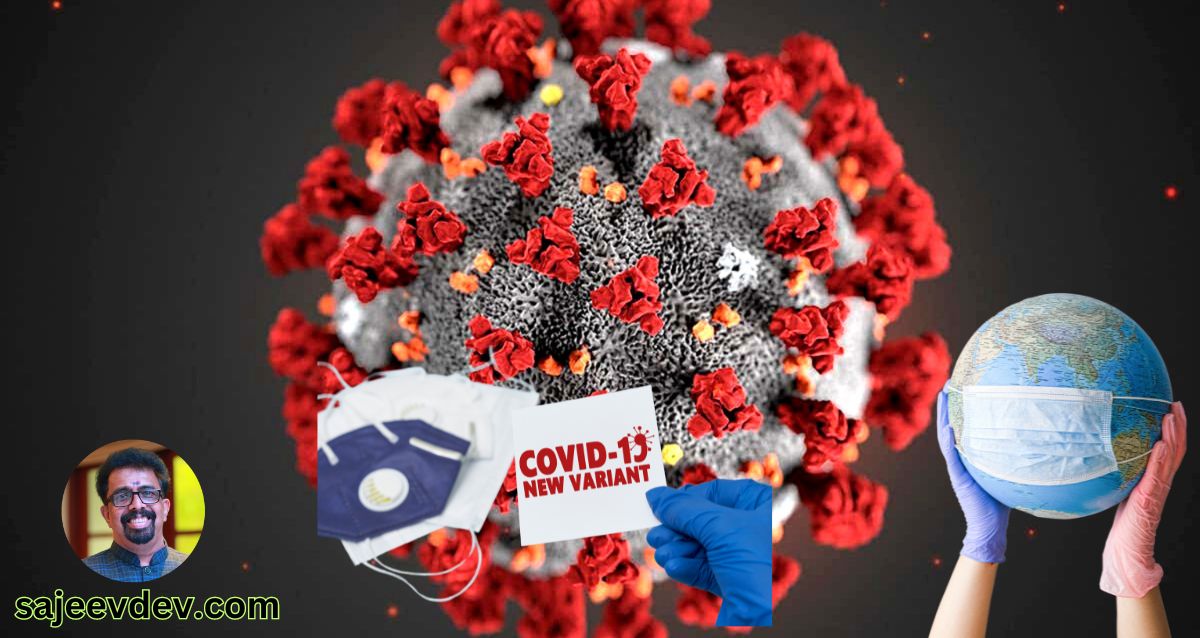The emergence of COVID-19 variants has significantly influenced the trajectory of the pandemic. Variants are essentially genetic alterations in the virus that arise due to mutations during replication
The emergence of COVID-19 variants has significantly influenced the trajectory of the pandemic. Variants are essentially genetic alterations in the virus that arise due to mutations during replication. The RNA virus responsible for COVID-19, SARS-CoV-2, is particularly prone to mutations, leading to the continuous emergence of new strains. These mutations can arise for various reasons, including errors during the viral replication process and selective pressures imposed by the host’s immune response or therapeutic interventions.
Variants can be classified based on their potential impact on transmissibility, severity, and vaccine efficacy. Some mutations may enhance the virus’s ability to spread, while others might alter its virulence. The World Health Organization (WHO) categorizes these variants into three main groups: Variants of Interest, Variants of Concern, and Variants of High Consequence. Each category reflects the level of public health scrutiny and concern associated with the variant’s genetic changes.
The significance of COVID-19 variants lies in their potential implications for public health strategies. Variants that exhibit increased transmissibility can lead to surges in cases, overwhelming healthcare systems. Additionally, certain variants may partially evade immunity conferred by previous infections or vaccinations, challenging public health responses. This evolving landscape necessitates continuous monitoring and genomic surveillance to identify and understand new variants promptly.
In the aftermath of the pandemic, understanding COVID-19 variants is crucial for effective mitigation strategies. By comprehending how these variants emerge and their implications, public health authorities can better tailor interventions, including vaccination campaigns and containment measures, to address the unique challenges posed by each variant. As research evolves, so will the strategies to combat the virus and protect global health.
Emergence of Omicron Sub-Variants
The emergence of Omicron sub-variants has significantly influenced the ongoing pandemic response worldwide. First identified in late 2021, the Omicron variant has rapidly mutated, resulting in several sub-variants, each exhibiting distinct characteristics. Among the notable sub-variants are BA.1, BA.2, BA.4, and BA.5, which have demonstrated increased transmissibility compared to earlier strains of the virus.
One of the primary concerns surrounding these sub-variants is their enhanced ability to spread. Data indicate that the Omicron sub-variants can outpace previous strains in terms of transmission rates, raising alarm among public health officials. Studies suggest that this increased transmissibility is largely due to mutations that allow the virus to evade neutralizing antibodies—a phenomenon that poses challenges for vaccination campaigns. While vaccines remain effective at preventing severe illness, the emergence of these sub-variants indicates a potential decline in vaccine efficacy against infection, necessitating ongoing research and potential updates to vaccine formulations.
The severity of illness caused by Omicron sub-variants has also been a topic of extensive investigation. Preliminary data suggest that these variants may lead to milder infections for many individuals compared to previous SARS-CoV-2 variants. However, the increased case numbers associated with their rapid spread could subsequently lead to higher rates of hospitalization and strain healthcare systems. Vulnerable populations, especially those unvaccinated or immunocompromised, continue to face significant risks from these variants.
In navigating the challenges posed by the emergence of Omicron sub-variants, public health responses must adapt. Efforts to encourage vaccination, booster distributions, and the implementation of targeted public health measures will be essential in mitigating the impact of these evolving strains. Continuous genomic surveillance is crucial to monitor and understand the characteristics of these sub-variants, ensuring that appropriate measures are taken to protect global health moving forward.
Current Status of Vaccination Campaigns
As of October 2023, the global landscape of COVID-19 vaccination campaigns presents a complex picture, shaped significantly by geographical, socio-economic, and political factors. Vaccination rates have varied widely across different regions, with high-income countries reporting up to 80% of their populations fully vaccinated, while low-income nations continue to struggle, achieving rates below 30%. This disparity raises concerns about global health equity and the potential for continued transmission of the virus in under-vaccinated populations.
The introduction of booster shots has added a new dimension to vaccination strategies. Many governments have initiated booster campaigns, particularly for vulnerable groups, to enhance immunity against emerging variants. However, uptake of these booster shots varies. In countries with high initial vaccination rates, booster administration has reached impressive levels, often exceeding 50%. Conversely, in areas plagued by vaccine hesitancy or supply chain disruptions, booster uptake is significantly lower, contributing to uneven protection and challenges in controlling outbreaks.
Moreover, the availability of vaccines remains a critical issue, particularly in regions like sub-Saharan Africa and parts of Asia. Despite global efforts to ensure equitable distribution through initiatives such as COVAX, logistical hurdles and local governance issues have hindered access to vaccines for various populations. This disparity not only impacts immediate health outcomes but also poses long-term risks, as unvaccinated individuals may become reservoirs for the virus, leading to potential mutations and further variants.
In conclusion, the current status of COVID-19 vaccination campaigns underscores a global health challenge characterized by inequality and varying levels of response. Addressing these disparities is essential for achieving a collective immunity that can aid in the mitigation of future variants and ensure a healthier global community moving forward.
Monitoring New Outbreaks
The ongoing management of COVID-19 variants necessitates robust surveillance mechanisms to effectively monitor new outbreaks. Public health authorities play a critical role in identifying and tracking these variants through a combination of strategies that enhance our understanding of the virus’s spread. One fundamental practice involves widespread reporting of new cases, which enables health officials to quickly assess the scale of an outbreak and implement appropriate interventions.
Data collection is central to this process. By obtaining timely information from healthcare facilities, laboratories, and even through community reporting, health authorities can identify spikes in cases that may signal the emergence of a new variant. Furthermore, epidemiological investigation methods, including contact tracing and outbreak response teams, are employed to determine the sources of transmission and the demographics affected. These proactive steps are essential in mitigating the impact of COVID-19 variants on public health.
In addition to case reporting, genomic sequencing has emerged as a powerful tool in understanding COVID-19. Through the analysis of viral genetic material, researchers are able to characterize and differentiate between variants. This process not only allows for the identification of new mutations but also helps track their prevalence within communities. By mapping these variants, health organizations can make informed decisions regarding vaccine effectiveness and the need for updated formulations.
Collaboration among international health organizations is also crucial for monitoring new outbreaks. Sharing data and findings between countries provides a global perspective on the spread of COVID-19 variants, which is vital for formulating comprehensive public health responses. Consequently, the integration of these monitoring strategies allows for an adaptive approach in managing new outbreaks, thereby safeguarding global health in the aftermath of the pandemic.
Healthcare Systems’ Capacity Management
The emergence of COVID-19 variants has significantly impacted the capacity management of healthcare systems worldwide. As new strains of the virus continue to evolve, hospitals and healthcare providers face the daunting challenge of effectively allocating resources to meet the demands of both COVID-19 patients and individuals requiring routine medical care. Adequate capacity management is essential to ensuring that healthcare systems are ready to respond to surges in cases while minimizing disruptions to non-COVID healthcare services.
One critical aspect of capacity management is hospital readiness, which involves maintaining sufficient beds, medical supplies, and personnel to accommodate fluctuating patient volumes. Healthcare facilities have implemented various strategic approaches to enhance their readiness; for instance, some have expanded their intensive care units (ICUs) and emergency departments to accommodate increasing patient numbers. Furthermore, triage protocols are continually reassessed to determine priority for admissions, ensuring patients with the most acute needs receive timely care.
The strain on healthcare workers cannot be overstated. Those on the frontlines are bearing the brunt of extended shifts and heightened stress levels, exacerbated by the persistence of COVID-19 and its variants. Supporting healthcare workers through mental health resources, adequate staffing levels, and streamlined workflows is paramount for sustaining an effective response. Only by addressing these challenges can healthcare systems maintain operational efficiency and safeguard their workforce.
Moreover, it is essential that healthcare systems do not lose sight of the importance of maintaining regular healthcare services, such as preventive care, chronic disease management, and elective procedures. These services are critical for overall public health and should coexist with COVID-19 response strategies. Thus, a balanced approach to capacity management that accommodates both urgent and routine healthcare needs will be crucial as societies continue to navigate the aftermath of the pandemic.
Post-Pandemic Recovery Strategies
As the world emerges from the unprecedented challenges posed by the COVID-19 pandemic, it is essential to adopt comprehensive strategies for post-pandemic recovery that address the multifaceted impacts on society. One of the primary areas requiring attention is mental health. The pandemic has significantly affected individuals’ psychological well-being, leading to increased anxiety, depression, and other mental health disorders. Governments and organizations must prioritize mental health resources, such as counseling services, community support groups, and educational campaigns, to foster resilience and assist those in need. Accessible mental health support is crucial for promoting emotional recovery among populations that have experienced loss and isolation.
In addition to mental health considerations, economic revitalization is a pressing concern as many industries continue to grapple with the aftermath of the pandemic. Employment rates have fluctuated, with certain sectors suffering more than others. Stimulus packages and targeted financial assistance must be implemented to support affected businesses and workers. Investments in green technologies, infrastructure projects, and small business development can stimulate job creation and economic growth while ensuring that recovery efforts are sustainable in the long term.
Furthermore, social support systems play a pivotal role in fostering community resilience during the recovery phase. Strengthening social safety nets, enhancing food security programs, and expanding affordable housing initiatives are essential measures to protect vulnerable populations. Collaboration between government entities and non-profit organizations can facilitate the delivery of resources and services to communities most in need.
Ultimately, a holistic approach to post-pandemic recovery that integrates mental health support, economic revitalization, and robust social systems is vital in navigating the long-term impacts of COVID-19 on communities around the world. These strategies will not only assist in recovery but also contribute to building a more resilient society for future challenges.
Preparedness for Future Health Crises
The COVID-19 pandemic has exposed vulnerabilities in global health systems, underscoring the urgent need for preparedness in facing future health crises. One of the most critical lessons learned is the importance of establishing robust public health infrastructure. This includes strengthening healthcare systems, enhancing surveillance mechanisms, and ensuring the availability of essential medical supplies. Investing in health infrastructure not only improves immediate response capabilities but also builds resilience against future outbreaks of infectious diseases.
Another essential aspect of preparedness is the allocation of adequate funding for research and development in the field of public health. This funding should focus on developing vaccines, diagnostic tools, and treatment modalities that can be rapidly deployed in response to emerging health threats. The pandemic highlighted the significance of swift scientific innovation and collaboration, which can be facilitated by long-term investments in health research. When health systems are well-funded, they can maintain a pipeline of advancements and mitigate the effects of new variants and potential pandemics.
Global cooperation has proved to be paramount in effectively responding to health crises. The interconnectivity of countries means that health threats can quickly transcend borders, necessitating a coordinated international response. Future preparedness should emphasize not only national strategies but also collaborative frameworks among nations. This involves sharing scientific knowledge, resources, and best practices to ensure every country is equipped to handle potential outbreaks. A unified approach can enhance the collective effectiveness of defense strategies against future threats.
In conclusion, the insights gained from the COVID-19 pandemic serve as a guide for future health crisis preparedness. By investing in public health infrastructure, ensuring adequate research funding, and fostering international collaboration, countries can better navigate the complexities of future health challenges, ultimately safeguarding global health. The lessons learned during this unprecedented time must inform and shape the way we prepare for the next health crisis.
Public Health Communication in the Era of Variants
Effective public health communication has emerged as a critical component in managing the complexities presented by COVID-19 variants. The rapid emergence and transmission of these variants challenge traditional messaging strategies and necessitate innovative approaches to ensure public understanding and compliance with health guidelines. Clear, consistent communication helps bridge the gap between health authorities and the general population, fostering an informed society capable of responding to shifting health dynamics.
One fundamental aspect of successful communication is the strategic promotion of vaccine uptake. Vaccination remains one of the most effective tools in combating not only the original strain of the virus but also its variants. Information campaigns should emphasize the safety, efficacy, and importance of vaccination while addressing common misconceptions. Messaging should be tailored to diverse audiences, utilizing digital platforms, local media, and community engagement to reach underrepresented populations. By acknowledging and addressing concerns sincerely, health authorities can enhance public trust and encourage individuals to make informed decisions regarding vaccination.
Moreover, compliance with health guidelines is paramount in mitigating the risks posed by variants. Clear, actionable guidance from health officials—such as mask-wearing and social distancing measures—must be communicated in a manner that resonates with the public. Visual aids, infographics, and concise messaging can simplify complex information, making it accessible to all demographics. Furthermore, integrating reputable sources into communications can strengthen the perceived credibility of the information shared and foster adherence to guidelines.
Trust in health authorities is essential for effective public health communication. Transparency, regular updates, and acknowledgment of shifting scientific understanding can bolster public confidence. By maintaining an open dialogue, health officials have the opportunity to cultivate a collaborative relationship with the community, which is vital for navigating the ongoing challenges posed by COVID-19 variants.
In addressing the complexities surrounding COVID-19 variants, it is crucial to reflect on the key themes that have emerged throughout this discussion
In addressing the complexities surrounding COVID-19 variants, it is crucial to reflect on the key themes that have emerged throughout this discussion. The ongoing evolution of the virus demands our persistent attention and adaptability. Variants pose significant challenges, not only in terms of their biological characteristics but also regarding their implications for public health measures, vaccine efficacy, and healthcare systems worldwide. The responses to these variants necessitate a comprehensive, informed approach that prioritizes scientific research and community engagement.
Public health authorities and governments must remain vigilant, monitoring the emergence of new variants and adapting strategies to combat them effectively. This underscores the importance of vaccination efforts, as widespread immunization can mitigate the effects of variants and curb transmission rates. Moreover, it is imperative to address the disparities in vaccine distribution to ensure equitable access for all populations, thereby promoting global health equity. The fight against COVID-19 and its variants is not merely a national or local issue; it is a global dilemma requiring international collaboration and solidarity.
Looking ahead, it is essential that we foster an environment of continuous research and development regarding vaccines and treatments. Scientific advancements hold the key to overcoming the challenges posed by COVID-19 variants. As new data emerges, public policies should adapt accordingly, guided by the principles of safety, efficacy, and accessibility. Ultimately, the collective effort of individuals, health organizations, and governments will be instrumental in navigating this ongoing crisis.
In conclusion, to effectively manage the aftermath of COVID-19 variants, we must commit to ongoing vigilance and proactive measures. This commitment will ensure both individual and community health while paving the way towards a resilient global health infrastructure. With sustained engagement and equitable actions, we can strive towards overcoming the challenges ahead.









